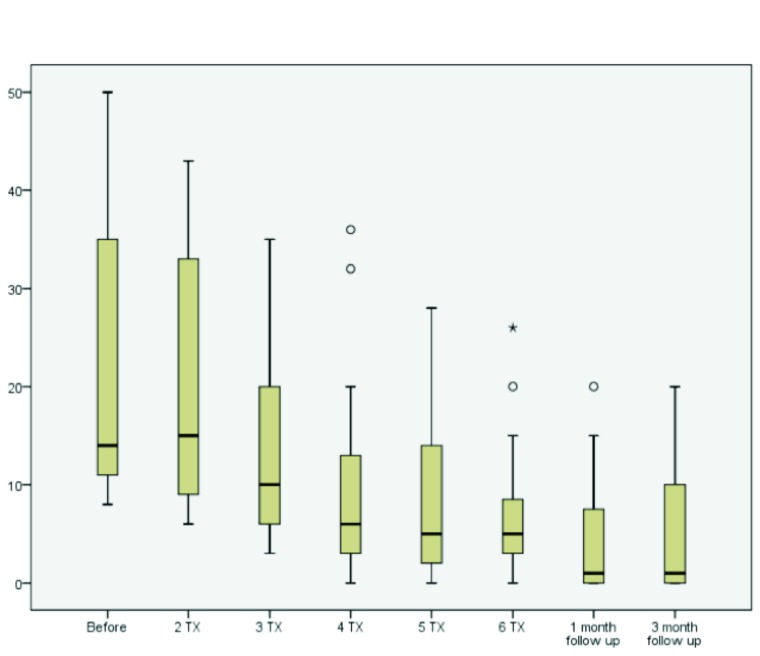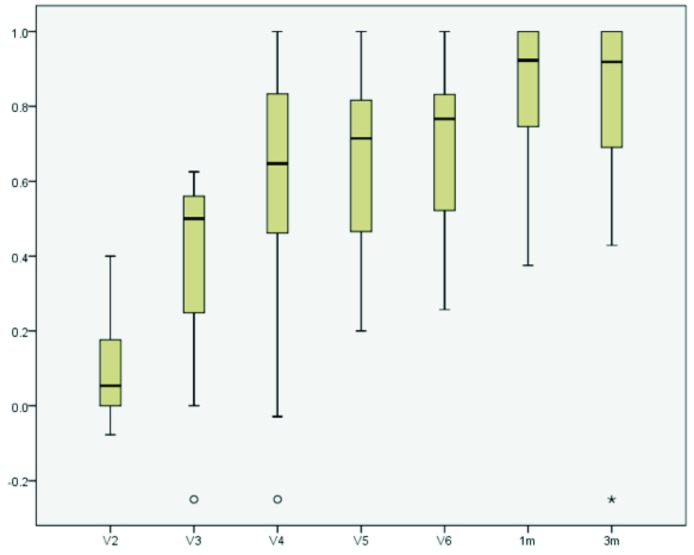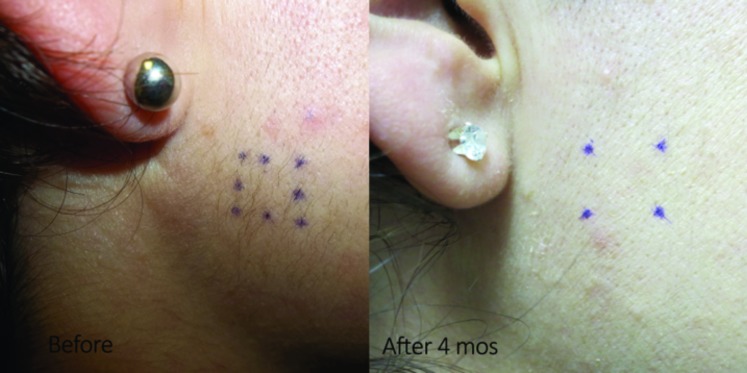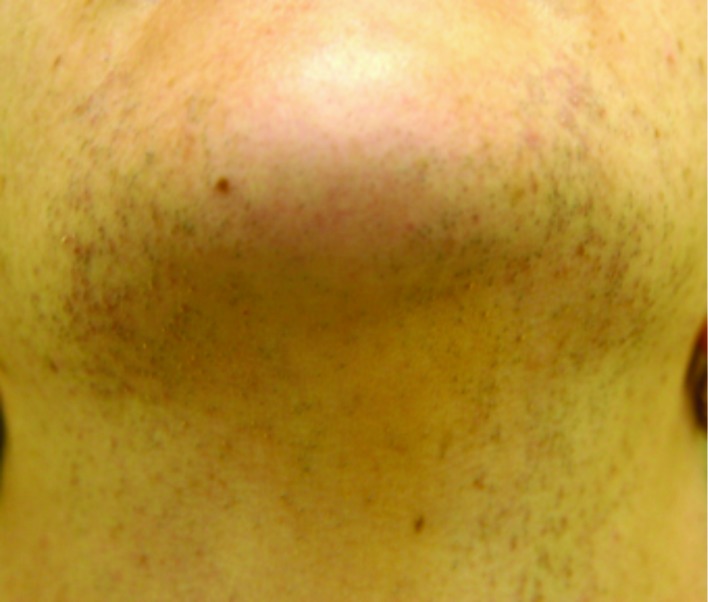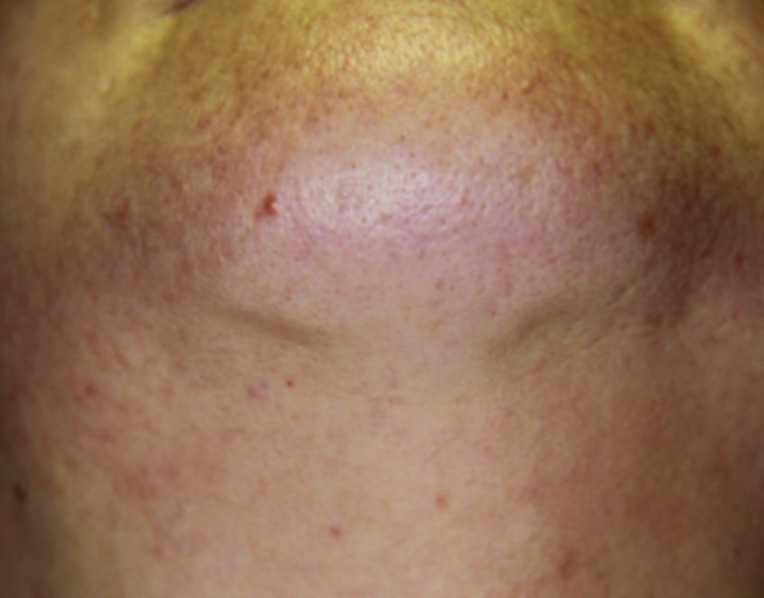Abstract
Objective: The purpose of this Institutional Review Board-approved, open label, prospective study was to study the safety and efficacy of a novel pulsed light home hair removal device in patients with unwanted facial hair. Materials and methods: Seventeen patients were recruited into the clinical trial; two patients were lost to follow-up. Patients received six biweekly treatments with the novel home-pulsed light device in the facial areas below the level of the cheekbone. Follow-up visits were made at one and three months following the last treatment. Results: The results showed statistically significant hair reduction numbers (22.7 at baseline to 4.4 at the end of the one-month follow-up time period and 7.0 at the end of the three-month follow-up time period) and percentages of 83.3 percent at one month post home-pulsed light device treatments and 78.1 percent at three months following the novel home-pulsed light device treatments. No adverse events with the device in the clinical evaluation were observed. Conclusion: This novel home use pulsed light device is a safe and effective at-home intense pulsed light device for facial hair removal.
Hair removal via lasers and light sources have been well-described in the medical literature over the past 20 years. Clinical studies have shown the safety and efficacy of these devices and the practice of removing hair via lasers and light sources has become routine in many clinical offices all over the world.1,2 Recently, home use lasers and light sources have entered into patients’ treatment armamentarium and clinical work documenting their safety and efficacy are needed to justify their use.
Intense pulsed light (IPL) devices for the removal of unwanted hair has been reported and is well-described in the medical literature.3-6 The use of IPLs for home use hair removal has also been well-described in the medical literature. In fact, this author and others have studied the system that was the subject of this evaluation previously and demonstrated it to be safe and effective. The IPL system that is the subject of these evaluations is known commercially as the Silk’n Glide.7-9
The novel, home-pulsed system is a low-energy IPL device that is currently available over the counter in the United States and elsewhere. It has a United States Food and Drug Administration (FDA) approval and is intended for general hair removal use in the home environment. The device follows the principles of selective photothermolysis in that it targets the melanin in the hair follicle and bulb for its hair removal effects.
The purpose of this current research project, performed under the auspices of an Institutional Review Board (IRB), is to study the novel home-pulsed system for hair removal on the face, in the area below the cheekbone line. This is an area that has not previously been studied as hair removal devices for home use are routinely evaluated with clinical trials utilizing body hairs. This is the first home use hair removal device study looking specifically at facial hair and looking at the effects of the treatment at each treatment visit and one and three months following the last hair removal treatment.
MATERIALS AND METHODS
This study was designed as an open label, prospective study to evaluate the safety and efficacy of the novel home-pulsed system device for facial hair removal, hair below the cheekbone line. The clinical trial was conducted at The Tennessee Clinical Research Center, Nashville, Tennessee. It was conducted under the auspices of the Sterling Institutional Review Board. All study-related material was at all times under ICH E-6 GCP Guidelines and ISO 14155 requirements.
All patients that entered into the clinical protocol read the protocol and signed an informed consent that had been approved by the IRB.
Seventeen female subjects were recruited to participate in this clinical trial for facial hair removal using the novel home-pulsed system device. The novel device uses a filtered Xenon lamp in a hand-held applicator that generates a pulse of light. It works via the theory of selective photothermolysis, using pulsed light in low optical fluences up to 5J/cm2. The light spectrum is set by the optical filters to be in the 475nm to 1200nm range of light, which is highly absorbed by the melanin in the hair shaft, the target for light in laser and light-based hair removal. The use of low optical energy is chosen to make the procedure safe on all skin types, and the ability to control the energy output allows the user safe and effective treatments. The device is shown in Figure 1.
Figure 1.
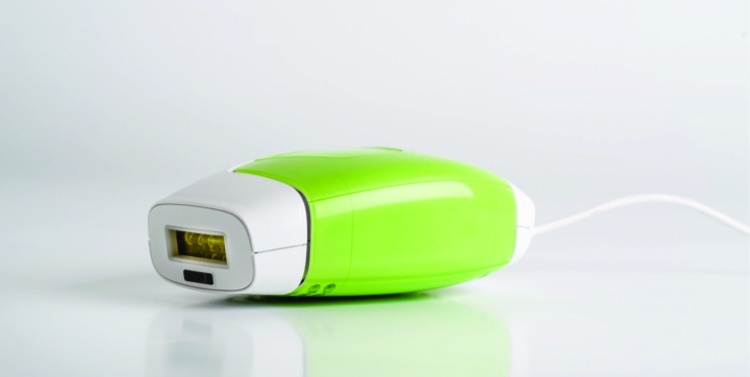
The pulsed light home hair removal device
Inclusion criteria for this clinical trial included the presence of unwanted hairs on the face, Fitzpatrick skin types from I to IV, and adult patients from age 21 years to 60 years of age. In addition, women were not to be pregnant and agreed not to become pregnant during the course of the study. Subjects also agreed to follow the treatment schedule, post-treatment care, and follow-up schedule to be included in the clinical evaluation.
Exclusion criteria for this clinical trial included no previous photoepilation, or laser or light-based hair removal or waxing in the treatment areas for at least three months prior to enrollment in this trial. The patient was excluded if there was the presence of a malignant or premalignant pigmented lesion in the treatment area prior to the procedure, scarring of any kind in the treatment area, or a history of hypertrophic scar or keloid formation. In addition, there was to be no history of known photosensitization or the use of a medication known to induce photosensitization; anticoagualtive medications or those with a thromboembolic condition were also excluded from the study. Pregnant or lactating female subjects were excluded from the study. Those who used nonsteroidal antiinflammatory drugs two weeks prior to the start of the clinical trial were excluded from participation; and patients had to not use these medications for two weeks following the treatment regimen. Patients with diabetes mellitus and those with a pacemaker or internal defibrillator were excluded from the study. Subjects with tanned skin in the treatment area or who have had exposure to strong sunlight or artificial tanning exposure within four weeks of the study were excluded. There could be no tattoo or permanent make-up in the treatment area. Exclusion criteria also included the presence of any dermatologic skin condition in the treatment area including eczema, psoriasis, and herpes simplex.
Subjects were also informed that they could withdraw from the study at any time for the following reasons: 1) whenever considered necessary for their welfare, 2) whenever the investigator judges that it is in the best interest of the subject, 3) if the subject cannot comply with the protocol, and 4) if a serious adverse event occurred.
The study is designed to have six treatment visits and two follow-up visits. Each of the treatment visits will be at two-week intervals and follow-up visits will be one and three months following the final treatment with the home-pulsed system device.
After signing the informed consent and meeting all screening eligibility according to the already-documented inclusion and exclusion criteria, baseline measurements were performed of each subject. These included collection of demographic data, laboratory tests to rule out pregnancy for female participants, and initial hair counts in the treatment area. The treatment area was selected and photographed before treatment initiation. The treatment area was defined as a lxlcm2 area on the face below the cheekbone line and was documented so as to be reproducible in further evaluations.
Patients were instructed on the proper use of this novel home-pulsed system and subjects performed the treatments on themselves, in the clinic, under the supervision of a trained nurse throughout the entire course of the treatment.
Energy levels for the treatments were matched to the subject’s skin type, with test pulses performed according to a prescribed table. Treatment was performed on the face, always below the cheekbone line, and for the purpose of defining anatomical landmarks and for photographic consistency and proper hair counts, zones were defined as either cheek, above upper lip, or below the lower lip.
A test pulse was performed on the darker part of the area to be treated. If no skin reaction was noted after 15 minutes of observation of the test pulse, a second test pulse was performed at one energy level higher than the original level. This test spot was observed as well. If side effects were noted after 15 minutes, the energy level was reduced by one level. Then the appropriate energy level for the treatment was selected and repeated for three pulses.
Treatment was performed by applying light pressure on the treatment area with the home-pulsed system device and pressing the trigger switch while maintaining good contact of the device’s light window with the skin. The applicator was then moved to the next spot to ensure full coverage of the area to be treated. Treatment was completed over the entire area that was selected for treatment, including the test site, a pre-determined and documented lxlcm2 area of skin on the face within the treatment area.
Post-treatment care included the application of a moisturizer cream to the treated area, and the patients were instructed to protect the treated areas from the sunlight for a minimum of two days following the light-based treatment.
Repeat treatments (Visits 2-6) were performed every two weeks. Photographs, utilizing standard digital camera, were taken at each visit prior to the treatment with the. novel home-pulsed system. Patients were evaluated for any adverse events and these were to be noted on the Case Report Forms. Follow-up visits after the procedures were scheduled at one and three months following the last treatment. Once again, photographs of the treatment areas were made and the patient evaluated for any untoward events.
RESULTS
Seventeen female patients were enrolled in this clinical trial; two patients were lost to follow-up during the course of study and were not included in the final data analyses for efficacy. The demographic data for the clinical trial are given in Tables 1 and 2 for patients’ age and distribution of skin type. Patients enrolled in this study averaged 39.1 years of age, were female, and had Fitzpatrick skin types III or IV.
TABLE 1.
Distribution of subjects’ age
| PP | FA | ||
|---|---|---|---|
| Age | N | 15 | 17 |
| Mean | 39.1 | 40.1 | |
| SD | 13.0 | 12.7 | |
| Min | 22.0 | 22.0 | |
| Max | 59.0 | 59.0 | |
| Percentiles | 25 | 29.0 | 29.0 |
| 50 | 34.0 | 40.0 | |
| 75 | 54.0 | 54.0 | |
TABLE 2.
Distribution of subjects’ skin type
| PP | FA | |||
|---|---|---|---|---|
| Fitzpatrick skin type | N | % | N | % |
| III | 13 | 86.7 | 15 | 88.2 |
| IV | 2 | 13.3 | 2 | 11.8 |
| Total | 15 | 100.0 | 17 | 100 |
The distribution of hair count is given in Table 3. P values for this evaluation were preformed using paired t-test analysis. From the table, a significant mean decrease in hair count was detected from treatment number three, p<0.001.
TABLE 3.
Distribution of hair count
| N | MEAN COUNT | STANDARD DEVIATION | MINIMUM COUNT | MAXIMUM COUNT | PERCENTILES | * p VALUE | ||||
|---|---|---|---|---|---|---|---|---|---|---|
| VALID | MISSED | 25 | 50 | 75 | ||||||
| Baseline | 15 | 0 | 22.7 | 14.6 | 8.0 | 50.0 | 10.0 | 14.0 | 35.0 | Ref |
| T2 | 15 | 0 | 20.5 | 13.0 | 6.0 | 43.0 | 7.0 | 15.0 | 35.0 | 0.092 |
| T3 | 15 | 0 | 14.5 | 11.1 | 3.0 | 35.0 | 6.0 | 10.0 | 25.0 | 0.001 |
| T4 | 14 | 1 | 10.4 | 11.3 | 0.0 | 36.0 | 2.8 | 6.0 | 14.8 | p<0.0001 |
| T5 | 15 | 0 | 8.5 | 9.2 | 0.0 | 28.0 | 2.0 | 5.0 | 20.0 | p<0.0001 |
| T6 | 15 | 0 | 7.4 | 7.5 | 0.0 | 26.0 | 3.0 | 5.0 | 10.0 | p<0.0001 |
| 1 month follow-up | 15 | 0 | 4.4 | 6.4 | 0.0 | 20.0 | 0.0 | 1.0 | 10.0 | p<0.0001 |
| 3 month follow-up | 15 | 0 | 5.1 | 7.0 | 0.0 | 20.0 | 0.0 | 1.0 | 10.0 | p<0.0001 |
The baseline hair count mean was 22.7±14.6. At the onemonth follow-up time visit, the mean hair count decreased to 4.4±6.4, p<0.0001. The mean delta is 18.3 and 95% confidence interval is 11.3 to 25.3. At the three-month follow-up time visit, the mean hair count was still significantly lower than baseline, noted to be 5.1±7.0, p<0.0001. The mean delta is 17.7 and the 95% confidence interval is 10.5-24.8. Box plot of hair counts and significance are shown in Figure 2. Table 4 shows the distribution of percent hair reduction. The percent hair reduction was calculated using the following formula: Percent of hair reduction (t) = (hair count [base] - hair count[t])/hair count(base). Box plot of percent hair reduction and significance are shown in Figure 3.
Figure 2.
Box plot of hair count
TABLE 4.
Distribution of percent of hair reduction
| N | MEAN | STANDARD DEVIATION | MINIMUM | MAXIMUM | PERCENTILES | * p VALUE | ||||
|---|---|---|---|---|---|---|---|---|---|---|
| VALID | MISSED | 25 | 50 | 75 | ||||||
| V2 | 15 | 0 | 10.3% | 15.0% | -7.7% | 40.0% | 0.0% | 5.4% | 22.2% | 0.019 |
| V3 | 15 | 0 | 36.5% | 25.9% | -25.0% | 62.5% | 23.1% | 50.0% | 56.5% | p<0.0001 |
| V4 | 14 | 1 | 56.4% | 35.3% | -25.0% | 100.0% | 41.8% | 64.8% | 84.8% | p<0.0001 |
| V5 | 15 | 0 | 65.2% | 24.6% | 20.0% | 100.0% | 37.5% | 71.4% | 83.3% | p<0.0001 |
| V6 | 15 | 0 | 69.8% | 23.8% | 25.7% | 100.0% | 42.9% | 76.7% | 83.8% | p<0.0001 |
| 1 month follow-up | 15 | 0 | 83.3% | 22.5% | 37.5% | 100.0% | 71.4% | 92.3% | 100.0% | p<0.0001 |
| 3 month follow-up | 15 | 0 | 78.1% | 34.2% | -25.0% | 100.0% | 66.7% | 91.9% | 100.0% | p<0.0001 |
Figure 3.
Box plot of percent hair reduction
A significant mean percent decrease in hair count was detected at all time points (p<0.001). Baseline hair count, as noted, was 22.7±14.6. At the one-month follow-up time period, the mean percent hair count decrease from baseline was 83.3±22.5 percent, p<0.0001. The 95% confidence interval is 71.9 to 95.8. At three months following the last visit, the mean percent hair count decrease from baseline was 78.1±34.2 percent, p<0.0001. The 95% confidence interval is 59.1 to 97.1.
No adverse or serious adverse events were noted from the study. Mild perifollicular erythema and edema occurred in all patients and resolved within a day of treatment. This was an expected event of treatment endpoint.
Photographic illustrations are shown in Figures 4 and 5.
Figure 4.
Before treatment with the pulsed light home hair removal device and four months after treatment
Figure 5.
Before and after treatment of the chin using the pulsed light home hair removal device
DISCUSSION
This author and others have described laser and IPL treatments for the removal of unwanted hair extensively over the past 20 plus years. In-office removal of unwanted hair is a proven modality with safety and efficacy established with numerous devices and the removal of unwanted hair with lasers and light sources is a common procedure in many clinics and spas all over the world. 1-6
The home use market for safe and effective devices for hair removal has been expanding over the past several years. Safe and effective are the key words that need to be emphasized time and time again. The devices in question must be safe and effective. In an article by Town et al,10 the authors looked at a variety of IPL home hair removal devices and found that many of them did not have the power outputs as described in their labeling, thus making the devices unable to deliver the promised efficacy in removing unwanted hair. Utilizing medical devices that have gone through the rigors of the FDA in terms of safety and efficacy is crucial in the home-use market.
The company that makes the pulsed light home hair removal device has studied IPL at-home hair removal for the past several years with several reports of safety and efficacy. In a multi-center study by Alster et al,9 175 patients were treated with the novel home-pulsed system device in a variety of sites on the body. They found that in 65 patients treated in the axillae, there was a 54-percent reduction in the hair at three months and a 41-percent reduction at six months post the last treatment received. They also evaluated 34 patients treated on the legs and found a 65-percent reduction at three months and a 54-percent reduction at six months. Fifty-six patients were treated in the bikini region with 56-percent reduction at three months and 43 percent at six months. They also looked at 20 patients with treatments on the arms and found that there was a 58-percent reduction at three months and 52-percent reduction at six months. There were no significant adverse events noted.
Gold et al,8 in 2010, reported on their experience with the novel home-pulsed system device. Twenty patients were evaluated in this IRB-clinical study. Patients received six bi-weekly treatments to the axillae and hair counts and photographic analyses were done at each visit and during the one- and three-month follow-up visits. The study showed a 78-percent reduction in hair at the one-month follow-up period and a 72-percent reduction in hair at the three-month time period. No adverse events were noted.
Goldberg et al9 also performed a study with the novel home-pulsed system device looking at home hair reduction in 13 individuals. The patients evaluated were skin types I to III and these patients received three treatments at two-week intervals and were then evaluated one month after their final treatment. One patient was lost to follow-up, but 11 out of the 13 were noted to have hair removal; one patient was noted to have developed postinflammatory hyperpigmentation that was noted one week after the first treatment, which subsequently resolved without sequelae.
The current study was the first evaluation of using the novel home-pulsed system or any home hair removal device on facial hair. The results support the use of this novel home-pulsed system on facial hair, with statistically significant hair reduction numbers (22.7 at baseline to 4.4 at the end of the one-month follow-up time period and 7.0 at the end of the three-month follow-up time period) and percentages being shown, that being 83.3 percent at one month post-treatments and 78.1 percent at three months following treatments. No adverse events with the device in the clinical evaluation were observed. Therefore, the authors conclude that the novel home-pulsed system s a safe and effective at-home IPL device for facial hair removal.
The major limitation for this study is that patients were followed for only three months after the last treatment. Based on hair growth cycles, perhaps a longer follow-up period would be warranted. Because of the home use part of this device, the study was designed with a three-month follow-up time period.
CONCLUSION
From the clinical trial performed, this novel home-pulsed system is a safe and effective at-home device for the removal of unwanted facial hair, with statistically significant results obtained in both hair count numbers and in the percentage of hair removed.
Footnotes
DISCLOSURE:Dr. Gold is a consultant for Home Skinovations. Ms. Biron and Ms. Thompson report no relevant conflicts of interest.
REFERENCES
- 1.Gold MH. Lasers and light sources for the removal of unwanted hair. Clin Dermatol. 2007;25(5):443–453. doi: 10.1016/j.clindermatol.2007.05.017. [DOI] [PubMed] [Google Scholar]
- 2.Dierickx CC. Hair removal by lasers and intense pulsed light sources. Dermatol Clin. 2002;20(1):135–146. doi: 10.1016/s0733-8635(03)00052-4. [DOI] [PubMed] [Google Scholar]
- 3.Gold MH, Ben MW, Foster TD, Street S. Long-term epilation using the Epilight Broad Band, Intense Pulsed Light Hair Removal System. Dermatol Surg. 1997;23:909–913. doi: 10.1111/j.1524-4725.1997.tb00746.x. [DOI] [PubMed] [Google Scholar]
- 4.Gold MH, Bell MW, Foster TD, Street S. One year foUow-up using an intense pulsed light source for long term hair removal. J Cutan Laser Therapy. 1999;1(3):167–171. doi: 10.1080/14628839950516823. [DOI] [PubMed] [Google Scholar]
- 5.Gold MH, Feng YM, Zhou ZC. Hair removal using a new intense pulsed light source in Chinese patients. J Gosmet Laser Ther. 2009;ll(2):94–97. doi: 10.1080/14764170902883220. [DOI] [PubMed] [Google Scholar]
- 6.Sadick NS, Shaoul J. Hair removal using a combination of conducted radiofrequency and optical energies—an 18-month follow-up. J Gosmet Laser Ther. 2004;6(1):21–26. doi: 10.1080/14764170410029013. [DOI] [PubMed] [Google Scholar]
- 7.Alster TS, Tanzi EL. Effect of a novel low-energy pulsed-light device for home-use hair removal. Dermatol Surg. 2009;35:483–489. doi: 10.1111/j.1524-4725.2009.01089.x. [DOI] [PubMed] [Google Scholar]
- 8.Gold MH, Foster A, Biron JA. Low-energy intense pulsed light for hair removal at home. J Clin Aesthet Dermatol. 2010;3(2):48–53. [PMC free article] [PubMed] [Google Scholar]
- 9.Boakye A, Hussain M, Goldberg D. Evaluation of a new in-home intense pulse light hair removal device; Skin Laser & Surgery Specialists of NY/NJ, New York, NY (personal communication). [Google Scholar]
- 10.Town G, Ash C. Are home-use intense pulsed light (IPL) devices safe? Lasers Med Set. 2010;25(6):773–780. doi: 10.1007/s10103-010-0809-6. [DOI] [PubMed] [Google Scholar]



